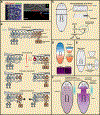The Cellular and Molecular Basis for Planarian Regeneration
- PMID: 30290140
- PMCID: PMC7706840
- DOI: 10.1016/j.cell.2018.09.021
The Cellular and Molecular Basis for Planarian Regeneration
Abstract
Regeneration is one of the great mysteries of biology. Planarians are flatworms capable of dramatic feats of regeneration, which have been studied for over 2 centuries. Recent findings identify key cellular and molecular principles underlying these feats. A stem cell population (neoblasts) generates new cells and is comprised of pluripotent stem cells (cNeoblasts) and fate-specified cells (specialized neoblasts). Positional information is constitutively active and harbored primarily in muscle, where it acts to guide stem cell-mediated tissue turnover and regeneration. I describe here a model in which positional information and stem cells combine to enable regeneration.
Copyright © 2018 Elsevier Inc. All rights reserved.
Figures






References
-
- Adell T, Saló E, Boutros M, and Bartscherer K. (2009). Smed-Evi/Wntless is required for beta-catenin-dependent and -independent processes during planarian regeneration. Development 136, 905–910. - PubMed
-
- Agata K, Tanaka T, Kobayashi C, Kato K, and Saitoh Y. (2003). Intercalary regeneration in planarians. Dev Dyn 226, 308–316. - PubMed
Publication types
MeSH terms
Grants and funding
LinkOut - more resources
Full Text Sources

